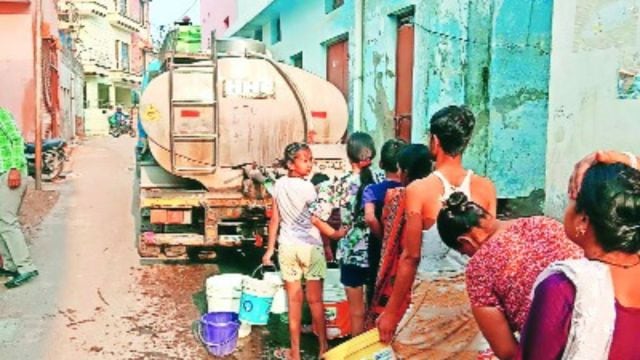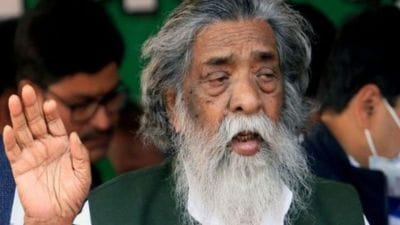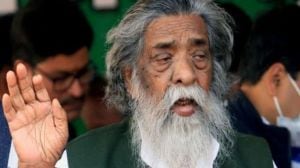Muddy water, dry tanks: Chandigarh reels under worsening water crisis
Across sectors and villages, residents face dirty or no water, low pressure, and rising health risks as civic response remains patchy.
 Residents of Kaimbwala village queue up with buckets and containers to collect water from a tanker (Express Photo)
Residents of Kaimbwala village queue up with buckets and containers to collect water from a tanker (Express Photo)Written by Prisha Arora
Once a symbol of modern urban planning, Chandigarh is now battling an intensifying water crisis. Across sectors and peripheral villages, residents are receiving muddy, low-pressure water — or none at all. Amid rising temperatures and monsoon warnings, frustration is mounting over the administration’s slow response and ageing infrastructure.
In Sector 19, Vijaypal Singh, Chandigarh president of Aam Aadmi Party and former Deputy Superintendent of Police, described the situation as dire. “We’ve been getting dirty water for the past 15 days. Villages were already suffering, and now even urban sectors are in the same situation. In Kaimbwala, residents are forced to drink cow’s milk because there’s no water at all. Animals are going without water too. We pay high taxes and steep water bills, but can’t even get clean drinking water. It’s unacceptable.”
Even in Sector 16, one of the city’s most affluent neighbourhoods, residents are grappling with discoloured water. “We receive water twice a day — morning and evening — and for the first 30 minutes both times, it’s completely muddy,” said Seema Sood, an entrepreneur. “We’ve been dealing with this for over a year. Despite repeated complaints, no action has been taken. We have to filter the water twice before use, and discard buckets every day. With monsoon approaching, the health risks are serious.”
 Muddy tap water collected in a Sector 16 home (Express photo)
Muddy tap water collected in a Sector 16 home (Express photo)
In Sector 15, banker Saurabh Mishra voiced disbelief at the situation. “I’ve lived here for two years, and this issue hasn’t gone away. I rely on bottled water for drinking and tank water for everything else. In 2025, how is it that Chandigarh can’t ensure clean water? This isn’t a luxury — it’s a basic right.”
Sector 18 homemaker Veena Agarwal described a similar pattern: “Every morning and evening, the water runs brown for the first 10 to 15 minutes. We’ve gotten used to waiting for it to clear before brushing our teeth or washing vegetables.”
In Sector 47-D, Amandeep Singh said the low pressure and poor quality have made daily life harder. “The first 30 minutes of supply is practically unusable. It takes an hour before the water becomes usable. We’ve filed several complaints, but there’s been no response.”
In the city’s outlying villages, conditions are even worse. At Kaimbwala, residents are experiencing a complete water blackout. “We’ve gone from receiving dirty water to receiving none at all. It’s been 15 days,” said Jaswinder Kaur. “The lake nearby has dried up and the fish have died. Every morning, we queue up to collect water from municipal tankers. Why are we being excluded like this?”
 Fresh water leaks from a punctured pipeline in Sector 24D (Express photo)
Fresh water leaks from a punctured pipeline in Sector 24D (Express photo)
At Khuda Ali Sher near the UT secretariat, Simranjeet Singh said the situation repeats every summer. “For the past 20 days, there has been no regular supply. We get water in buckets from the Municipal Corporation. The Leheri connection promised months ago hasn’t been delivered. We’ve even escalated it to the Mayor’s office. Nothing has changed.”
Environmental activist L R Budaniya, a known city social worker, blamed the city’s crumbling infrastructure. “Water pipes across the city have developed cracks, allowing soil to enter the lines. When water flows, it carries the mud directly into homes. Just yesterday, I recorded a leak in Sector 36. I’ve sent many such videos to the public health department. They respond in isolated cases, but the problem is systemic, especially in the older, northern sectors.”
In Sector 7, resident Ish Sharma said water quality and supply pressure are both poor. “When the water arrives, it runs brown for the first half hour. The pressure is so low we can’t fill our storage tanks. On days when there’s no supply, we rely on tanker water. It’s a stopgap, not a solution.”
From Sector 33B, Kuljinder Sra, general secretary of the Residents’ Welfare Association, said, “This reflects extremely poorly on the civic administration. Chandigarh is failing to meet even the most basic environmental and health standards. Clean water is not a privilege — it is a fundamental right.”
H S Lucky, president of the Chandigarh Congress and a former Deputy Mayor, added, “The issue is not just muddy water -— it’s the complete lack of water supply. The pressure is really low. Forget muddy water, we are not even getting water. I don’t understand what the issue is.”
Damaged filters
While many have installed water purifiers, technicians warn that turbid water can damage filtration systems.
“Muddy water is full of suspended particles. These clog filters quickly and increase maintenance costs,” said a city-based water purification expert. “RO and UV systems are especially sensitive — frequent replacement becomes expensive.”
Doctors are sounding the alarm. “Muddy water is a breeding ground for harmful microorganisms,” said Dr Rishi Nagpal of Nagpal Medicare, Sector 11, Panchkula. “It can cause gastrointestinal infections, diarrhoea, vomiting, and skin conditions. It’s especially risky for children, the elderly, and immunocompromised individuals.”
Dr Arvind Sahni, Director of Gastroenterology at Max Super Speciality Hospital, Mohali, warned, “Apart from sand and silt, muddy water may contain faecal matter. This can cause jaundice, dysentery, and cholera. Boiling isn’t enough — proper filtration and chemical treatment are essential.”
As summer intensifies and monsoon nears, residents fear that administrative inaction could lead to a full-blown public health crisis. For now, across Chandigarh’s gleaming sectors and overlooked villages, the water may differ in clarity — but the frustration remains the same.
(The writer is an intern with The Indian Express)












